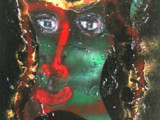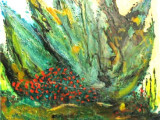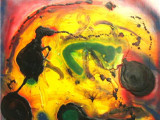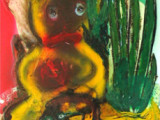Strange Attractors
I understand that there will probably be public misunderstanding and scientific disagreement with using ‘strange attractors’, as applied in Chaos Theory, in describing one’s art. But, if “a prime characteristic of a strange attractor is that it is defined as the focus of a pattern of seemingly chaotic behaviour” then it does not seem inappropriate for me to apply strange attractors to my paintings in the series Strange Attractors.
I asked myself this question: Is there a sense in which art can be understood as ‘strange attractors’? In attempting to answer this question I held the exhibition “Strange Attractors.” The images were painted and are not computer generated. I do not use fractals, as I believe it is equally appropriate for intuitive applications in one’s art to create in a chaos-like environment.
Therefore, the series of paintings shown as “Strange Attractors,” 25 paintings in the series, all works on masonite and given a specific title was a natural out-growth on my part from the eight previous paintings I did earlier [2002] in which I tried to define what I believe to be the Eight Forces in Chaos. In the eight paintings in that series [Eight Forces in Chaos] I concluded that there did exist eight identifiable forces in chaos and I titled these paintings as: Mind, Initiation, Challenge, Position, Counter, Margin-Edge, Depth, and Return.
“Perhaps the great merit of chaos theory is its ability to orient understanding to respond creatively to complexity. As such it is a tool to counter-balance the simplistic efforts of the many honourable initiatives to come up with a set of values applicable to all in a complex, multi-cultural society subject to a wide variety of pressures.” Paper prepared for the 13th World Conference (Finland, August 1993) of the World Futures Studies Federation (WFSF).*
These intangible attractors in the exhibition Strange Attractors were a direct result of my intuitive experience searching for what compels one while painting. At the Ogunquit Art Association, Barn Gallery in Maine I displayed some of the smaller works in this series.
*Those interested in learning more of Chaos Theory, without all the mathematical applications, may want to read The Essence of Chaos by Edward N. Lorenze, University of Washington Press, 1994. In addition see: Barbara Regent’s thesis, University of Newcastle, 2002, “Reflective Qualities of the Artistic Creative Process and Chaos Theory. A Study of the Relationship and the Implications for Art Education and Teaching.”
 Salazar
Salazar







